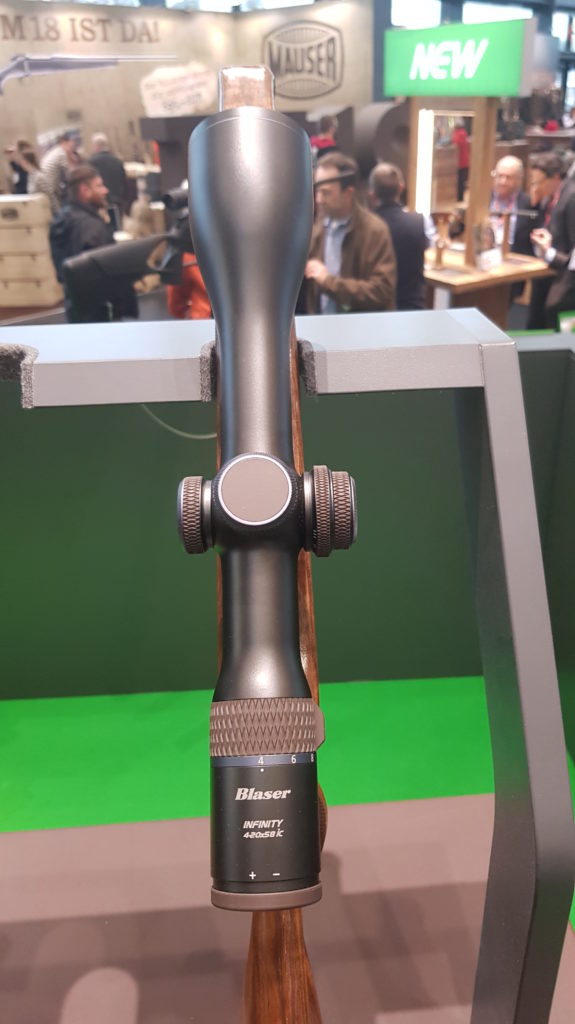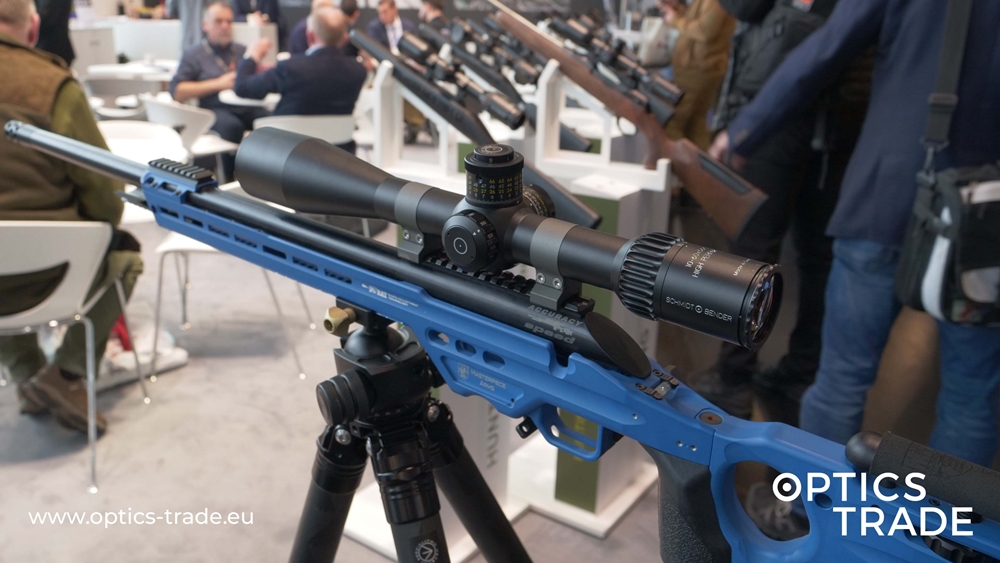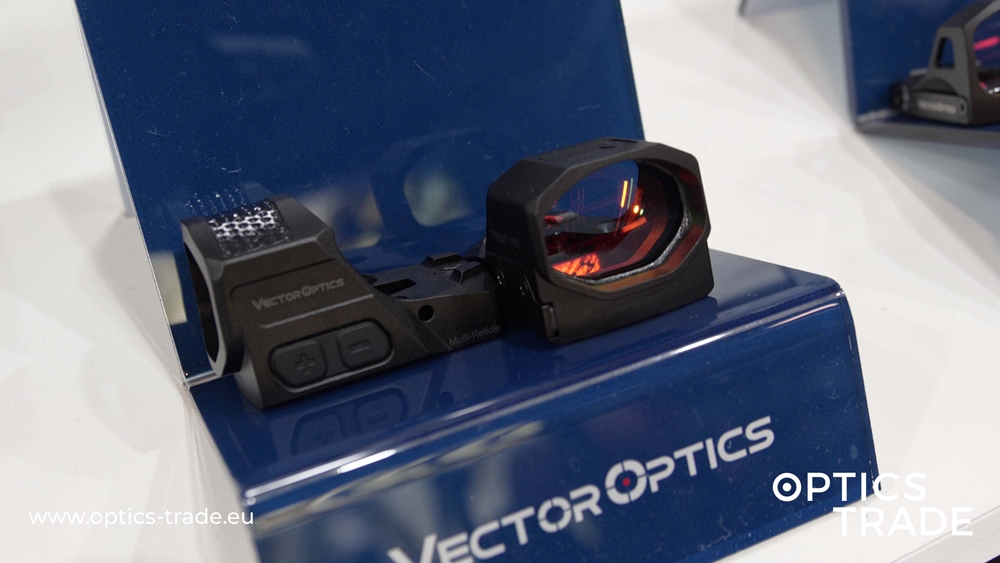Introduction
When Blaser introduced their Primus binoculars last year, we all knew that it was just an overture to a larger project. Blaser did not wait long to take the next step. This year, they delighted their fans by expanding their offer of optics with a riflescope series called Infinity. Optically and design-wise, these are on the same level as riflescopes of the highest quality class currently on the market.
Before we move on to the characteristics of the Infinity series, let’s discuss how Blaser’s optics came to be. The following information might not be 100 % credible – this is just how we believe it unfolded. In 2000, Sauer & Sohn, Blaser, Mauser, and Swiss Arms united under the name of SIGARMS. The conglomerate of companies then bought Minox and Optronika GmbH who used to produce top-notch Premier Reticles riflescopes. Together, these two companies formed GSO (German Sports Optics). One of their projects was the great tactical riflescopes Minox ZP. Looking at them, we expected that GSO would eventually do something for Blaser as well – and we think that they did. Based on the reputation of Blaser and GSO, we had high expectations for the Infinity series.

Model range
1–7×28 iC
This model is relatively heavy for a wide angle riflescope. It features a true 1x magnification, meaning that it can be used with both eyes open without problems. The reticle is in the first focal plane. The specialty of this model is that it features an illuminated dot that turns on either in the second or in the first focal plane, depending on the set magnification. Blaser calls this system IVD (Intelligent Variable Dot). This is how it works on a prism: when the magnification is set from 1x to approx. 4x, the dot is in the second focal plane. Once the magnification is set to more than 4x, the dot in the second focal plane powers off and powers on in the first focal plane. A configuration like this can also be found in Docter Basic, Schmidt & Bender ShortDot and Minox ZP8 riflescopes. The light transmission is affected a little because there is an additional prism in the interior of the riflescope. This system allows quick target acquisition when shooting at close range and provides minimum coverage when shooting at targets farther away.
2.8–20×50 iC
The all-around model with a universal magnification range. It is suitable for all hunting situations, be it mountain hunting, stalking or shooting from a hide.

4–20×58 iC
This model is made for hunting in low light. This is the only riflescope from the Infinity series that features a 5x zoom factor instead of 7x. It is designed to offer maximum light transmission.
Characteristics of the Infinity series
Blaser Infinity riflescopes have a unique design – we haven’t seen anything similar on the market before. They go extremely well with the successful Blaser R8 rifles, which is why many of the current R8 owners might be convinced that it is time to change the optic. The riflescopes feature a 36mm tube and can only be mounted via rail. Not including an option to mount the riflescope with rings is a bold move – and a right one, in our opinion. We hope that other optics manufacturers will follow Blaser’s steps and that in 10, 20 years, riflescopes of the highest quality class will no longer be mounted with rings.

The wide angle model and the all-rounder from the Blaser Infinity riflescopes series feature a 7x zoom factor while the low light specialist has a 5x zoom factor. What we find a little strange is that they all have the reticle in the first focal plane. For now, these are the only premium hunting riflescopes with the reticle in the first focal plane. The reason behind Blaser’s decision for an FFP reticle probably has to do with a desire to achieve absolute precision. With SFP riflescopes, the point of impact changes slightly as you manipulate with magnification. Renowned optics manufacturers such as Zeiss and Swarovski; however, have managed to achieve that the point of impact moves for a negligible amount. Blaser, who entered the premium class of optics, could do the same. We expect that for the next generation of these riflescopes, Blaser will include an option to choose an SFP reticle. With a zoom factor of 7x, an SFP configuration would be a welcome addition.

Furthermore, Blaser chose to switch the positions of the windage turret and the illumination control turret. The windage turret can now be found on the left and illumination control turret on the right. For left-handed shooters, this is great in terms of ergonomics; for right-handed shooters, not so much. The switching of the positions might be the consequence of Blaser’s endeavor to be different from what’s already on the market. The 2.8–20×50 and 4–20×58 have an adjustable parallax. When set to 100 m, the parallax adjustment turret is half-locked – you have to pull the turret out in order to set the parallax to any other distances. This is a great feature because the user will immediately notice if the parallax is not set at 100 m.
The all-rounder and the twilight specialist come with a BDC turret. We have mixed feelings about the design of the turret. The good side is that the turret can be locked at two different settings – at zero, or five centimeters above zero (five clicks on the turret). When shooting at approx. 100 m, the option to lock the elevation turret at +5 is really a nice addition. At all the other settings, the turret remains in the raised position; the user cannot lock it. We also liked the zero stop and the fact that the BDC turret is a single turn turret. The bad side is that for now, there are no distance markings on the turret, only clicks, which is untypical for a ballistic turret – Blaser might add that in the future.

The riflescopes from the Infinity series feature an illuminated reticle – the intensity can be set to suit either daylight or dusk. Blaser also added a position sensor that „communicates“ with a Blaser rifle that has an iC cocking slide. The dot is automatically activated when the slide is set into a ready-to-fire position. Blaser calls this function iC (illumination control). This function was first introduced with Zeiss Victory Varipoint iC riflescopes.
Some were afraid that the first focal plane reticle would be too thick on the maximum magnification, but now that we have tested it, we can disprove such predictions. The reticle is not too thin on low magnifications and not too thick on high magnifications. The design of the reticle is acceptable but some may argue that for hunting, a second focal plane reticle is a must have.

Conclusion
Blaser is a renowned company with plenty of followers. Because of their reputation, they were in a great position to expand their offer of products. Judging by what we have seen at IWA this year and last year, Blaser has taken its leap into the world of optics very seriously. We are absolutely sure that the Infinity series will sell well. There are 3 main reasons: 1st: It’s made by Blaser; 2nd: The optics are superb and 3rd: the design is unique. The riflescopes are expected to be available in Spring 2018. The retail prices will be as follows:
1–7×28 iC – approx. 2600 EUR
2.8–20×50 iC and 4–20×58 iC – approx. 3300 EUR





Hello Andraz, that is quite an interesting review. I am curious as to why Blaser opted for a 36 mm tube! What is your opinion on this?
Hello Sir,
the big main tube diameter has much more elevation and windage adjustment available, for shooting on very long ranges.
On the Blaser, you have 80 clicks available when you zero your rifle in, so you could shoot around 700-800 meters with a .308 win, or even over 1000 meters with a flatter trajectory caliber for comparison.
Hope this information helps.
Thank you!
very good. thanks for the share. did you need some hunting Riflescopes. there is a good website for shopping hunting Riflescopes.
very good. thanks for the share. did you need some hunting Riflescopes. there is a good website for shopping hunting Riflescopes.